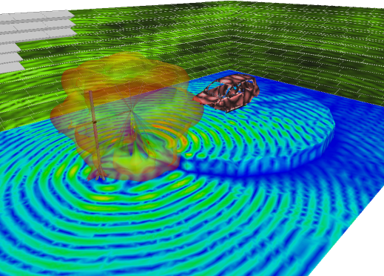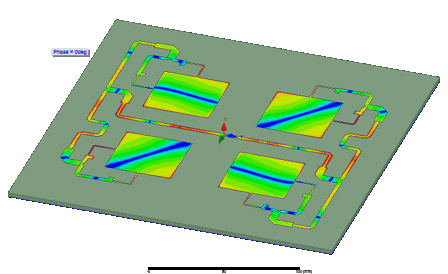Ansys HFSS
Develop and simulate high-frequency electronic items such as antennas, components, interconnects, connectors, ICs, and PCBs with this multipurpose full wave 3D electromagnetic (EM) simulation software.
Develop and simulate high-frequency electronic items such as antennas, components, interconnects, connectors, ICs, and PCBs with this multipurpose full wave 3D electromagnetic (EM) simulation software.
Ansys HFSS is a high-frequency structure simulator that can be used to design and simulate high-frequency electronic items. This includes antennas, antenna arrays, RF or microwave components, high-speed interconnects, filters, connectors, IC packages, and printed circuit boards. Ansys HFSS software is used by engineers all over the world to develop high-frequency, high-speed electronics that can be found in communications networks, advanced driver assistance systems (ADAS), satellites, and internet-of-things (IoT) devices.
Its dependable automated adaptive mesh refinement allows engineers to concentrate on the design, rather than spending hours figuring out the correct model mesh.
In addition, Ansys HFSS stands out from all other EM simulators due to its automation and guaranteed accuracy.
In comparison, competing EM simulators require manual user control, and numerous solutions to ensure that the generated mesh is suitable and accurate.
A sustainable design method requires an understanding of the variables affecting antenna performance when put on practical platforms.
In the modern era, there are antennas almost everywhere. Integrated ground-based communication systems now span to a variety of applications. From commercial uses like smartphones, RFID tags, and wireless printers to defense applications such phased array antennas for aircraft radar systems or autonomous vehicles.


With Ansys HFSS, designers can replicate “what if” real-world scenarios by using electromagnetic simulation to examine antenna design and its relationship to the complete system.
Engineers may use Ansys Electronics Desktop to diagnose, isolate, and remove EMI and radio-frequency issues (RFI) early in the design cycle by combining the unparalleled precision of Ansys electromagnetic 3D and 2.5D field solvers with the efficient circuit- and system-level solution in Ansys RF Option.
Users can use Electronics Desktop’s seamless workflow, which includes advanced electromagnetic field solvers, to predict EMI/EMC output of electrical devices by dynamically linking them to power circuit simulators. These integrated workflows eliminate expensive repeated EMC qualification checks and redundant design iterations.
Engineers may determine the overall performance of their electrical devices and build interference-free designs using several EM solvers designed to resolve a variety of electromagnetic problems, as well as the circuit simulators in Electronics Desktop.
Radiated and conducted emissions, susceptibility, crosstalk, RF desense, RF coexistence, cosite, electrostatic discharge, electric fast transients (EFT), blast, lightning strike effects, high intensity fields (HIRF), and radiation hazards are only a few of the issues that need to be addressed (RADHAZ), electromagnetic environmental effects (EEE), electromagnetic pulse (EMP) to shielding effectiveness and other EMC applications.
For modeling mounted antenna-to-antenna coupling, EMIT works hand-in-hand with Ansys HFSS to combine RF device interference analysis with best-in-class electromagnetic simulation. As a result, a complete solution for reliably predicting RFI effects in multi-antenna environments with multiple transmitters and receivers has been developed.
All significant RF interactions, including non-linear device component effects, are computed by EMIT’s powerful analysis engine. In a laboratory environment, diagnosing RFI in complex environments is notoriously challenging and costly. Fortunately, using EMIT’s dynamic related results views, the root-cause of any interference can be quickly identified by graphical signal trace-back and diagnostic summaries. The diagnostic markup displays the precise origin and direction that interfering signals take to each receiver.
If the source of the interference is identified, EMIT allows for a quick assessment of different RFI mitigation options in order to find the best solution. The new HFSS/EMIT Datalink makes it possible to construct an RFI analysis model in EMIT directly from the physical 3-D model of the mounted antennas in HFSS. This allows for a smooth end-to-end workflow for a full RFI solution in RF environments ranging from large platform cosite interference to electronic device receiver desense.
Engineers may use advanced unit cell simulation in Ansys HFSS to model infinite and finite phased-array antennas. This includes all electromagnetic effects, such as mutual coupling, array lattice definition, finite array edge effects, dummy components, and element blanking.
In addition, under any beam scan situation, a candidate array design may analyze the input impedances of all components. Based on element match (passive or driven) far-field and near-field pattern behavior over any scan condition of interest, phased array antennas can be optimized for performance. That is, at the element, subarray, or complete array stage.
For conditional settings, one or more antenna elements are mounted inside a unit cell frequency in infinite array modeling. To create an infinite number of elements, the cell includes periodic boundary conditions on the surrounding walls to mirror fields. Fortunately, this method is particularly useful for predicting array-blind scan angles, which may occur when array beam steering is used.
In short, this technology enables full array analysis, which includes the prediction of all mutual coupling, scan impedance, element patterns, array patterns, and array edge effects.
SI Circuits, when combined with HFSS, can be used to analyze signal integrity and power integrity. In addition, EMI issues in PCBs, electronic packages, connectors, and other complex electronic interconnects, caused by shrinking timing and noise margins.
From die-to-die across ICs, bundles, connectors, and PCBs, HFSS with SI Circuits can handle the complexities of modern interconnect design. Engineers can understand the performance of high-speed electronic products well before constructing a prototype in hardware, saving time and money. By leveraging the HFSS advanced electromagnetic field simulation capability, dynamically integrated at the circuit and device level, engineers have complete control over the design process.
Circuits and RF systems simulation technologies, when combined with HFSS, construct an end-to-end high-performance workflow for RF, EMI/EMC, and other applications.
EMIT, a multi-fidelity method for predicting RF device output in complex RF environments with multiple sources of interference, is included. EMIT also includes diagnostic tools for easily identifying root-cause RFI issues and resolving issues early in the design process.
Ansys HFSS simulates 3-D full-wave electromagnetic fields for accurate and rapid design of high-frequency and high-speed electronic components.
Ansys Maxwell simulates 2-D and 3-D low frequency electromagnetic fields for accurate and rapid design of electromagnetic and electromechanical devices.
Ansys Icepak provides electronic cooling solutions that utilize the industry leading CFD solver for T&F flow analyses of integrated circuits, PCBs and electronics.
Ansys SIwave is a specialized design platform for power integrity, signal integrity and EMI analysis of electronic packages and PCBs.
Ansys Q3D Extractor provides 2-D and 3-D parasitic extraction for engineers designing electronic packaging and power electronics.
Electronics Desktop is a unified platform for electromagnetic, circuit and system simulation. Free download available for students!
Nuhertz FilterSolutions provides automated RF, microwave and digital filter design, synthesis and optimization in an efficient, intuitive process.
Ansys Motor-CAD is a specialized electric machine design tool that allows for quick multiphysics simulation over the entire torque-speed working range.
Delivers simulations of cloud-to-ground lightning strikes, high-intensity radiated fields & emissions, EM pulses, EMI/EMC, crosstalk and more.